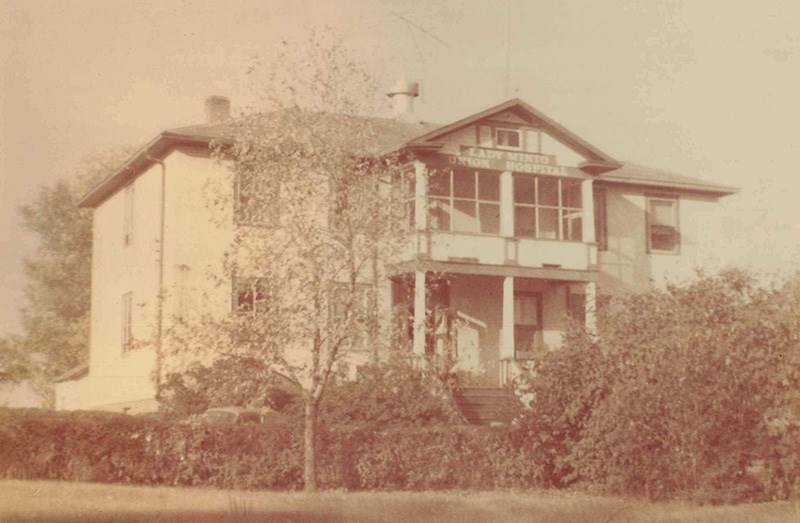Submitted
Lady Minto Health Care Center (LMHCC) in Edam will be the scene Aug. 2 of celebrations to mark the 100th anniversary of the very first Lady Minto hospital in the community.
The centennial event will be held from 2-4 pm outdoors at LMHCC, with snacks and refreshments, and a program beginning at 2:30. Everyone is welcome. If you are coming to the celebration, please bring your own lawn chair. In case of inclement weather, the event will be moved indoors at LMHCC.
“The management and staff of Lady Minto HCC couldn’t let this remarkable anniversary pass without recognizing our history in a special way,” said lifelong Edam resident and LMHCC recreation Co-ordinator Lynette La Clare.
“We are very proud of our facility’s history, right back to the first Lady Minto Hospital that served the community for 50 years – from 1917 to 1967. A new Lady Minto Union Hospital was built in Edam in the 1960s and was the home of local health care services for 25 years, from 1967 until 1992. In 1992, the Union Hospital was replaced by the new Lady Minto Health Care Center which is itself 25 years old this year,” explained La Clare.
The Aug. 2nd celebrations ommemorate all three Lady Minto facilities that respectively have been central to the community for the past century. Each has its own unique story, beginning with vibrant and determined community members intent on addressing the health care needs of their fellow Edam and area citizens, and a benevolent woman committed to the building of cottage hospitals in remote areas across Canada.
The original Lady Minto Hospital in Edam was officially opened in February 1917 – the first hospital north of North Battleford. The project was initiated by local and area residents following the departure in early 1915 of Edam’s lone physician to serve in World War I. Residents and settlers in the area were determined to secure the services of another physician and believed that a hospital was urgently needed.
Following numerous meetings, the Rural Municipalities of Turtle River and Parkdale, and the Village of Edam entered into an agreement to build, equip, maintain and operate a hospital in Edam. Costs were shared according to a set formula and ratepayers in the municipalities readily supported the proposed tax levies.
The project was also supported by a $3,000 loan from the Lady Minto Cottage Hospital Fund, a benevolent organization instituted by Lady Mary Caroline Grey, 4th Countess of Minto (Lady Minto), wife of Gilbert John Murray Kynynmound Elliot (4th Earl of Minto), Governor-General of Canada from 1898 – 1904. The fund supported the building of cottage hospitals in remote districts across Canada. Cottage hospitals were small rural buildings with several care beds to provide health services at the local level by a local physician so that people didn’t have to travel great distances to larger centres for emergency and everyday care.
The loan came on the condition that nurses of the Victorian Order of Nurses (VON) be hired for the Edam hospital. Lady Minto was an honourary president of the VON. A shortage of VON nurses eventually negated the requirement and the money remained with the hospital as a gift.
Edam’s Lady Minto Hospital was one of 43 established in communities and isolated areas across Canada. Each was named after Lady Minto with only a small number – including one in Cochrane, Ontario and on Salt Spring Island, British Columbia - retaining the Lady Minto name to the present day.
Lady Minto lived in Canada during her husband’s tenure as Canada’s eight Governor General from 1898 to 1904. She visited Western Canada in 1901. Lord Minto also travelled throughout the country, in particular visiting former locations where he had served as an Aide-de-camp to General Frederick Middleton during the North West Rebellion. Some of those sites were in what would later become Saskatchewan.
The Edam hospital was designed by W. H. Evans, architect, of Saskatoon and contracted to A. Gigot of North Battleford. Research suggests that the Edam hospital was designed by the same architect who designed the Carnegie Library in North Battleford, now the Allen Sapp Gallery. Construction of Edam’s Lady Minto Hospital began in 1916 and was completed in February 1917.
Just prior to operation, in January 1917, the Provisional Board responsible for the new hospital was notified by letter from the Province of Saskatchewan that the Board’s plan to operate the hospital with tax dollars was not in accordance with the law and regulations of the Department of Public Health. The Board was advised that as the law stood at the time, municipal and union hospitals could be built, equipped and maintained with tax dollars, but could not be operated with tax money.
Provisional Board members and local municipal representatives quickly sent a delegation to Regina “with instructions to stay there till they had obtained a change in the existing law” (P.W. Farnsworth, secretary-treasurer, Provisional Board) making legal what the Board was doing and what it proposed to do to operate the hospital. In an article written by Mr. Farnsworth in 1967, he noted that the “delegation came back from Regina with a special act of the legislature, legalizing what we had done and allowing us to levy up to four mills throughout the hospital area for operating costs. The act is known as “The Lady Minto Union Hospital Act at Edam”, 1917.”
Lady Minto Hospital in Edam opened in February 1917. Farnsworth believed that it was the first hospital in Saskatchewan to provide so-called “free” hospitalization, paid for via local tax levies rather than by individual users.




